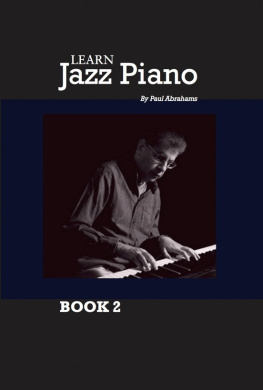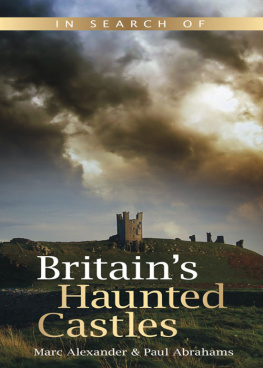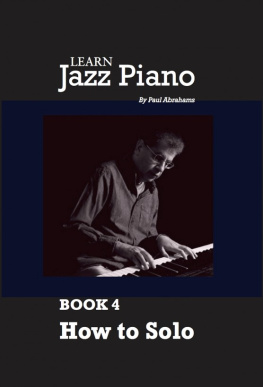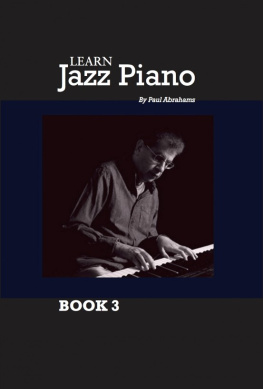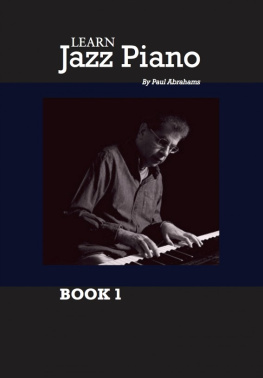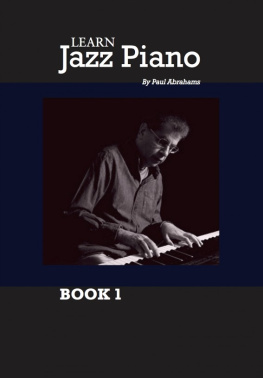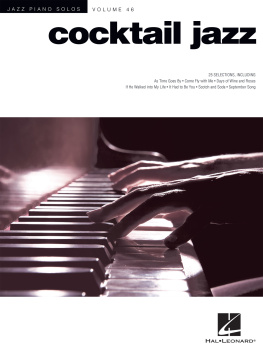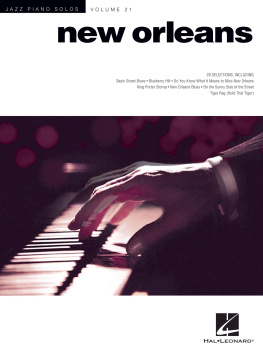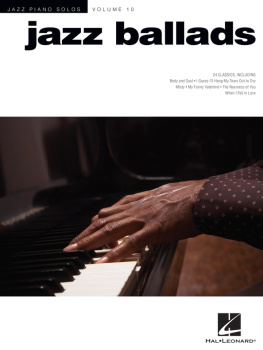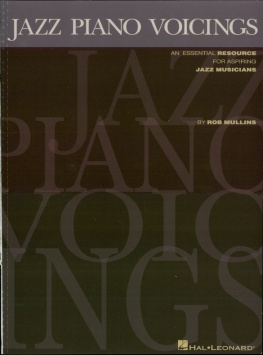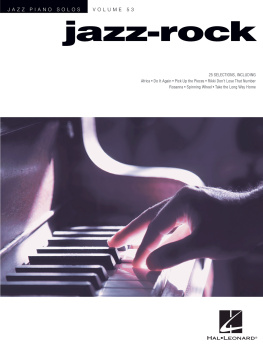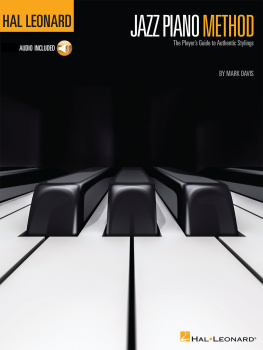Paul Abrahams - Learn Jazz Piano Book 2
Here you can read online Paul Abrahams - Learn Jazz Piano Book 2 full text of the book (entire story) in english for free. Download pdf and epub, get meaning, cover and reviews about this ebook. publisher: Paul Abrahams, genre: Children. Description of the work, (preface) as well as reviews are available. Best literature library LitArk.com created for fans of good reading and offers a wide selection of genres:
Romance novel
Science fiction
Adventure
Detective
Science
History
Home and family
Prose
Art
Politics
Computer
Non-fiction
Religion
Business
Children
Humor
Choose a favorite category and find really read worthwhile books. Enjoy immersion in the world of imagination, feel the emotions of the characters or learn something new for yourself, make an fascinating discovery.
- Book:Learn Jazz Piano Book 2
- Author:
- Publisher:Paul Abrahams
- Genre:
- Rating:5 / 5
- Favourites:Add to favourites
- Your mark:
- 100
- 1
- 2
- 3
- 4
- 5
Learn Jazz Piano Book 2: summary, description and annotation
We offer to read an annotation, description, summary or preface (depends on what the author of the book "Learn Jazz Piano Book 2" wrote himself). If you haven't found the necessary information about the book — write in the comments, we will try to find it.
With over 100 illustrations, book 2 of Learn Jazz Piano journeys further into the heart of jazz and blues improvisation. In non-technical language Paul Abrahams explains such concepts as rootless voicings and tritone substitution.
Learn Jazz Piano Book 2 — read online for free the complete book (whole text) full work
Below is the text of the book, divided by pages. System saving the place of the last page read, allows you to conveniently read the book "Learn Jazz Piano Book 2" online for free, without having to search again every time where you left off. Put a bookmark, and you can go to the page where you finished reading at any time.
Font size:
Interval:
Bookmark:
Published by Paul Abrahamsat Smashwords www.learnjazzpianoonline.com This ebook is licensed foryour personal enjoyment only. This ebook may not be re-sold orgiven away to other people. If you would like to share this bookwith another person, please purchase an additional copy for eachreader. If youre reading this book and did not purchase it, or itwas not purchased for your use only, then please return toSmashwords.com and purchase your own copy.
Thank you for respecting the hard work of this author. Paul Abrahams, 2011 Authors note Although this book can be read independently, Iwould recommend that each section be studied alongside my onlinevideo course Learn Jazz piano, which can be found here: Learn Jazz PianoOnline with Paul Abrahams Together with each online video lesson, I havebundled four backing tracks, downloadable sheet music and aquiz. --------------------- This book is part of series of three eBooks calledLearn Jazz Piano.
Clickhere to purchase book 1.
Clickhere to purchase book 3. There is also a fourth book called How ToSolo . --------------------- At the start of some chapters I have indicated whichvideo lesson relates to the text. TABLE OF CONTENTS Terminology For obvious reasons, more Americans than Britsfollow my lessons. So after numerous emails asking me what I meanby a crotchet, Ive mended my ways and now refer to quarter notes.This also means that swing quavers are now swing eights. Withapologies to my British readers Ill also be using the followingterms, which appear in the left-hand column.
Intervals USA / UK half step / semitone whole step / tone Note names USA / UK whole note / semibreve half note / minim quarter note / crotchet eighth note / quaver However, as a token act of rebellion, Ill continueto speak of key centres rather than centers. Naming chord symbols As no two books use the same chord symbol names, Imopting for the following: 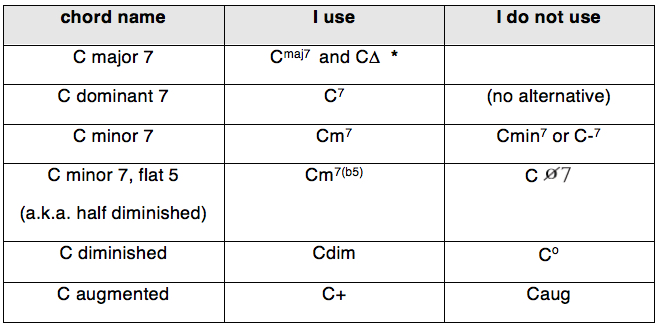 * In book 1, I used the triangle for a major7. In this book Im mostly using maj7.
* In book 1, I used the triangle for a major7. In this book Im mostly using maj7.
I suggest you get used to working with both symbols. Naming extensions As the name suggests, extensions are notes playedabove the octave. They should therefore be referred to as 9, 11 and13. When these extensions are flattened or sharpenedthey become b9, # 9, # 11 and b13.
These four altered extensions arecommonly known as alterations. However, if these added notes occur within achord they should, in theory, be referred to as 2, 4 and 6 etc. Unfortunately, the world isnt that simple and thesame note can be described in a number of ways. For example, # 11 will often be referred to as b5. Hereare the possibilities: 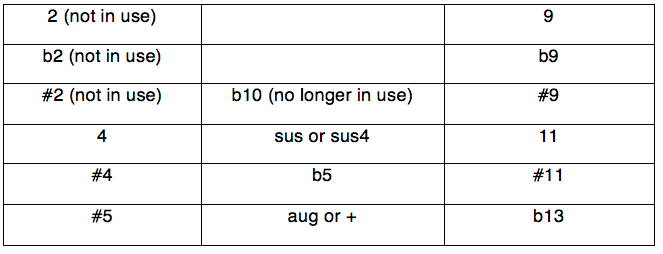 You will also encounter + and - signs instead of # and b. I suggest that you get used toseeing # 11 and b5 as the same note.
You will also encounter + and - signs instead of # and b. I suggest that you get used toseeing # 11 and b5 as the same note.
Thisalso goes for b13 and # 5. Keep in mind, however, that in a chord such asC7(b5), the 5 (G) is being replaced by the flat 5 (Gb) and therefore needs to be described as such. Compare this with the chordC7 ( #11 ) . Here,although the note in question is still the same, it is now analteration rather than a replacement of the G. It is thereforedescribed as sharp 11. I feel a migraine coming on! Glossary Alteration of flattening or sharpening anextension.
Bridge The middle B section of a song. Also known as the middle8. Comp The piano accompaniment to a solo. Extension Added note not within the basic harmony of achord. Head The original tune before and after the solos. Horizontalimprovisation The scale stays constantthroughout chord changes.
Interval The space between two notes. Key centre The key connecting a group of relatedchords. Lead sheet Melody plus chords. Mode A scale generated from the major or melodic minorscale. Rhythm changes The chord sequence based on Gershwins I GotRhythm. Rootless voicing A left-hand chord that removes the root note fromthe bottom of the chord.
It is usually replaced with 3 or7. Standard A well-known tune favored by jazzmusicians. Tonic The first pitch of a diatonic scale. Tritone An interval of 3 whole steps. Turnaround A chord sequence that takes youback to the start or on to the next section. A common turnaround isI VI II V.
Verticalimprovisation Each chord has an influenceover the improvised notes. Walking 3s Linking the 3 rd note of eachchord. Walking 7s Linking the 7 th note of eachchord. Introduction Animagined Q&A Q Surely, playing jazz is all about instinctand invention. How can I freely express myself with a head full oftheory? A Errol Garner is just one instance of a jazz master who,apparently, couldn't read music. However, unless you are a genius,you need more than just good instinct.
As for a clear head, the wayforward is to put in the work until the theory becomes secondnature. Then stop thinking. Q Can I get by with just asound knowledge of each chord and its extensions andalterations? A Only to a certain extent - a gooddeal of the excitement of jazz comes from the concept of movingfrom tension to release. This is created by the dominant 7 chordresolving to its tonic: V I: the perfect cadence. All the tension is contained in thisV chord and we create this tensionwith notes known as extensions and alterations. These are notes notwithin the chord.
The re are threeextensions: 9, 11 and 13. When we flatten or sharpen theseextensions, they become alterations. The four alterations are b9,#9, #11 and b13. By combining these extensions and alterations withthe basic notes of a dominant 7 chord, we create the tension thatwill release into the tonic chord. Q Is it helpful torecognise the scale and mode that relates to each chord? Forexample, if I play G Mixolydian over G , it will include 9 and11. Is this useful? A Yes, very useful, and to create more tension you could tryother scales such as the diminished, whole tone and LydianDominant.
But always keep in mind that the sole use of thisapproach results in the unmusical sound of running up and downscales rather than playing anything creative. ==================== The realityis that you need to combine knowledge of the chord'sextensions and alterations,together with the scales and modes that fit the chord. Yes, thisinvolves a lot of work that needs to become second nature before'instinct' kicks in. Believe me, I'm not belittlinginstinct. Indeed, the only time I feel I'm playing a decent solo iswhen I'm not thinking. The last thing I want to be doing isconsciously going for a diminished scaleor #9.
In the same way,when speaking, I'm not thinking about letters of the alphabet; I'vedone that work. For people that say jazzis self-indulgent, they ought to acknowledge how much work andpreparation masters like Coltrane, Bill Evans and Sonny Rollins putin before they used instinct. ==================== The aim By the end of this book, you will possess apractical knowledge of the following: Rootless voicings and how theyrelate to scales, modes and extensions. New scales: Lydiandominant, altered, diminished and whole tone Use of the Phrygianmode Block chords Rhythm changes Tritonesubstitution Diminishedtheory Upper structures An introduction tostride Requirements This book follows onfrom book 1 and itsaccompanying video lessons. By this point you should have a soundunderstanding of turnarounds, the II V I sequence andextensions. Chapter 1: RootlessVoicing Video lesson 15: rootless voicing Up till now, your left hand has mostly beenplaying 2-note shells, these two notes being either 1 + 7 or 1 + 3of the chord.
Here are the shells of theII V I progression in the key of B b . 
Font size:
Interval:
Bookmark:
Similar books «Learn Jazz Piano Book 2»
Look at similar books to Learn Jazz Piano Book 2. We have selected literature similar in name and meaning in the hope of providing readers with more options to find new, interesting, not yet read works.
Discussion, reviews of the book Learn Jazz Piano Book 2 and just readers' own opinions. Leave your comments, write what you think about the work, its meaning or the main characters. Specify what exactly you liked and what you didn't like, and why you think so.

